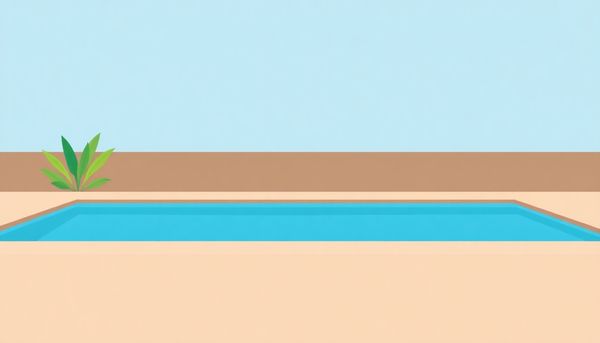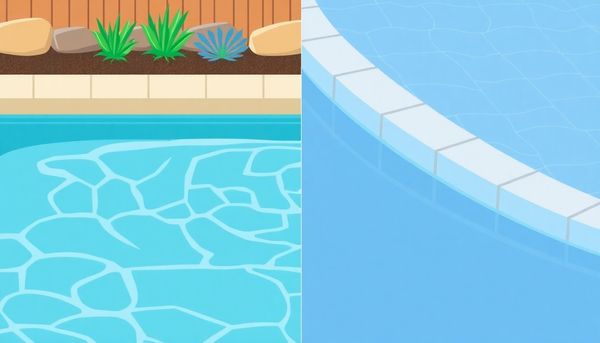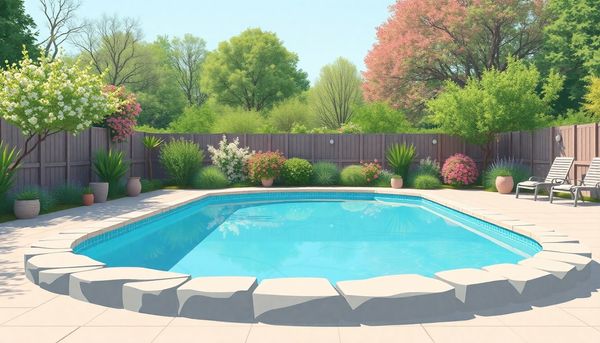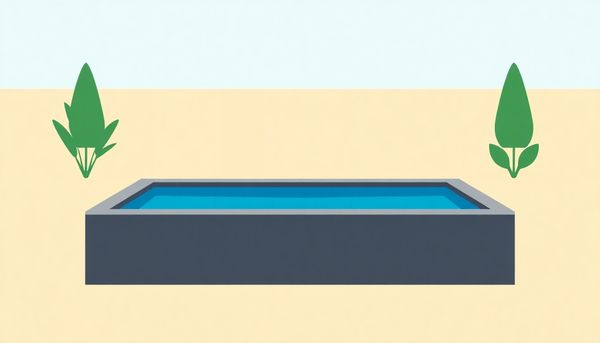Understanding Pool Coping: Essential for Safety and Style
October 10th, 2024
October 10th, 2024
When you think of a swimming pool, your mind likely conjures visions of refreshing water, playful splashes, and sunlit afternoons. But beneath this idyllic scene lies a crucial component that often goes unnoticed: the pool coping. This essential element forms the finishing edge around your pool, performing the dual role of practical necessity and aesthetic enhancement.
Growing up, my family’s backyard oasis was not just a pool but a gathering place for laughter and leisure. I recall my father meticulously choosing the pool coping material, stressing its importance as much for safety as for style. This decision was not just about completing the look. It was about creating a smooth, rounded edge that prevented the inevitable poolside mishaps, providing a comfortable surface for sitting or reclining.
Pool coping is more than a decorative rim. It acts as a protective border that shields the pool structure from water damage, diverts water away, and provides a non-slip surface for swimmers. Without it, your pool might succumb to premature wear and tear, leading to costly repairs. And when chosen thoughtfully, coping enhances the overall appearance, seamlessly blending the pool with the surrounding landscape.
In essence, pool coping is an unsung hero in pool design and maintenance, merging function with fashion. Whether you're a new pool owner or considering a renovation, understanding the importance of coping can transform your aquatic escape into a safe and stylish retreat.

There's something undeniably captivating about the fine details that make a swimming pool feel complete. Pool coping stands as one of those crucial elements, often overlooked but immensely valuable. Think of it as the elegant brim of a hat, adding not just style but essential protection to your pool. Coping acts as a graceful barrier, preventing water from seeping behind the pool shell and causing potential damage. It’s more than just a practical solution; it’s an opportunity to showcase your personal taste and style.
Every time I visit my friend’s home, I can’t help but admire her pool’s travertine stone coping. It harmonizes perfectly with the lush foliage surrounding her backyard, creating a seamless transition from pool to nature. This careful selection not only enhances the pool's aesthetic appeal but also withstands the wear of sun and water with minimal maintenance. It's experiences like these that demonstrate the importance of choosing the right coping material.
Options range from the timeless beauty of natural stones to the modern versatility of composite materials. Each choice offers unique benefits and potential challenges in terms of maintenance and durability. Whatever your preference, the addition of a sealant can be crucial, safeguarding your coping from water damage and providing a non-slip surface for safety. When thoughtfully chosen and properly installed, pool coping transforms any swimming space into a polished and inviting aquatic escape.
Navigating through the sea of pool coping materials can feel like wandering through a hardware store on a lazy afternoon: there are numerous choices, each with its own perks and quirks. Your decision not only affects the pool's safety but also the aesthetics of your backyard oasis.
Brick, a timeless option, offers a classic look with the added benefit of being easy to replace. Its durability against the elements makes it a solid contender, and it comes in a variety of colors to match your style. A friend once shared how a single misplaced cannonball led to a cracked brick—thankfully, fixing it was a breeze.
Pavers, close cousins to bricks, stand out for their resilience and low maintenance. They come in several finishes, allowing you to customize your poolside experience without much hassle. Plus, pavers show impressive resistance to salt and water, ensuring longevity.
Natural stone brings a touch of elegance and ruggedness to your pool. From granite to travertine, each option offers unique textures and colors. Just be mindful: some stones, like travertine, might need extra attention with sealants to keep them in top shape.
Composite materials, such as pre-cast concrete, provide flexibility in design and affordability. They can be molded into various shapes and sealed for added durability, making them a practical choice for many pool owners.
Choosing the right material is as much about personal taste as functionality. Explore these options, and you'll find the perfect balance between beauty and practicality for your pool haven.
A pool isn’t just a body of water; it's an oasis of leisure, a retreat from the daily grind. The right coping can transform this backyard feature into a stunning visual masterpiece. Consider the subtle beauty of natural stone coping, which brings an earthy elegance that complements lush garden surroundings. Its durability means less time worrying about maintenance and more time luxuriating in your poolside sanctuary.
Variety is key when it comes to enhancing your pool's aesthetics through coping. Perhaps you're drawn to the rustic charm of brick, offering a hint of nostalgia with every splash. Each brick can be uniquely tinted, contributing to a mosaic that mirrors the hues of your home. Or, for those seeking a sleek, contemporary vibe, composite materials provide a smooth, modern finish without compromising on resilience.
The tactile experience is just as important as the visual. Imagine stepping out and feeling the gentle warmth of sun-kissed pavers beneath your feet, or running your hand along the smooth curve of a cantilever edge. These details create an inviting space that beckons you to unwind.
Choosing the right coping is about more than aesthetics; it’s about creating a cohesive atmosphere that reflects your style. By thoughtfully selecting materials and designs, you add layers of personality and sophistication to your pool, turning a simple swim into an exquisite experience.
Ensuring safety and durability with pool coping is akin to giving your beloved pool a sturdy backbone. Without it, the harsh elements of nature and continuous water exposure may wreak havoc on your investment. Imagine sitting by your pool, feeling the warm sun on your skin, not having to worry about splintering edges or unsightly damage. That peace of mind comes from the right coping choice.
Start with materials that withstand time and weather. Brick, stone, or composite materials are not just aesthetic choices; they are practical decisions aimed at longevity. These materials fend off erosion and wear, thus ensuring that your pool remains as welcoming as the day it was completed. A well-maintained coping also prevents water from seeping into the pool structure, which could lead to complex and costly repairs.
Safety is equally paramount. A slip from wet, hazardous edges can turn a relaxing day into an unwanted incident. Opt for non-slip finishes or textures that provide grip. It’s a small detail that can make a huge difference, especially when children are involved.
Moreover, regular maintenance, like sealing, keeps your coping in peak condition. It guards against the subtle wear that comes from constant exposure to chlorinated water. By investing in quality materials and proper upkeep, you enhance your pool's durability, ensuring it remains the glittering centerpiece of your backyard sanctuary for many years.

Selecting the right pool-coping material is akin to choosing the perfect accessory for an outfit: it needs to complement the overall design while being robust enough to withstand daily wear. Each material offers unique advantages, making the decision both exciting and crucial.
Consider natural stone like travertine or granite. These materials not only exude timeless elegance but also boast impressive durability. My neighbor, who chose travertine for her pool, swears by its classic appeal and the way it withstands the elements with minimal maintenance. However, remember that porous stones may need extra sealing to ward off water absorption.
For those preferring a more customizable approach, composite materials such as pre-cast concrete present a versatile option. They can be molded into various shapes and styles, allowing for a tailored fit. A close friend opted for this, appreciating the seamless look it provided around his pool while remaining cost-effective.
Brick and pavers offer another practical and aesthetic choice. Their wide array of colors and ease of replacement make them ideal for those who value flexibility. A family in my neighborhood recently revamped their pool area with paver coping, finding the process straightforward and the results stunningly cohesive.
Ultimately, the best material integrates seamlessly with your pool’s environment while ensuring longevity and safety. By investing time in selecting appropriate coping, you enhance not only the visual appeal of your pool but also its structural integrity, ensuring countless summers of enjoyment.
Selecting the right materials for pool coping is crucial to ensure both durability and aesthetic appeal. When I was exploring options for my own pool, I quickly realized that not all materials can withstand the relentless sun and frequent splashes of chlorinated water. This prompted a deeper dive into weather-resistant choices that promise longevity and style.
Brick, for instance, is a time-tested favorite. Its robust nature makes it an excellent candidate for pool coping. Not only does it come in an array of colors and sizes, but its individual pieces can be easily replaced, which is a blessing for maintenance. Moreover, bricks are naturally slip-resistant, making them a safe option for families.
Natural stone, such as granite and marble, offers an unmatched elegance and considerable strength. While the initial cost might be higher, stones like granite are incredibly durable, standing firm against the elements with minimal upkeep. Sandstone, on the other hand, adds a different texture and color palette to your poolside but requires a bit more attention due to its porous nature.
For those seeking a more customizable solution, composite materials like pre-cast concrete are worth considering. These can be shaped and molded to fit any design vision while offering substantial resistance to both water and salt. Adding a sealant enhances their lifespan, making them a smart choice for areas prone to extreme weather conditions.
Ultimately, selecting weather-resistant materials for pool coping not only protects your investment but elevates the entire pool experience, ensuring that your oasis remains inviting and safe for years to come.
Selecting pool coping involves more than just practicality—it's a canvas for personal expression. Each choice tells a story about the pool owner, reflecting their style and aesthetic preferences. Are you drawn to the timeless elegance of natural stone, with its rich textures and earthy hues, or do you favor the polished sophistication of concrete with its clean, modern lines?
Consider the emotional pull of each material. Natural stone, such as travertine or granite, evokes a sense of tranquility and connection to the environment. Imagine the sun setting over the water, with the stone absorbing the day’s warmth underfoot. In contrast, sleek composite materials offer flexibility in design, allowing you to mold a contemporary masterpiece that mirrors your cutting-edge tastes.
Color is another vital aspect. A vibrant red brick might complement a lively, playful garden, while a muted sandstone could seamlessly blend with a serene Zen-inspired retreat. Even the choice between a rough-hewn or smooth finish can significantly influence the pool's aesthetic, offering either a rustic charm or a minimalist elegance.
Ultimately, your pool coping should harmonize with your existing landscape and architectural elements, creating a unified visual experience. As you weigh your options, let your imagination wander and allow your personal style to guide you in crafting a poolside escape that is uniquely yours.
Nothing quite dampens the allure of a backyard pool like concerns over safety. While pool coping is often praised for its aesthetic and protective qualities, it also plays a crucial role in enhancing safety features around your aquatic oasis. Consider those moments when playful splashes make their way to the poolside. Here, the right coping material can prevent potentially hazardous slips. A non-slip surface becomes essential, especially for households with energetic children or lively pool parties.
Materials like textured stone or grooved concrete are not just visually appealing; they offer the grip needed to keep footing secure around wet areas. Some pool owners have found success using composite coping with integrated non-slip elements. It’s a small yet impactful step that can save a tumble or two. Additionally, the gentle curve or bullnose design of many coping options eliminates sharp edges, reducing the risk of bumps and scrapes during poolside activities.
Beyond just the edge, attention to the drainage capabilities of your coping can prevent water from pooling on your deck, further minimizing slip hazards. A thoughtfully designed coping system ensures that water is efficiently guided away from high-traffic areas. By choosing the appropriate materials and designs, you’re not only investing in style but actively safeguarding your loved ones.

When considering the safety features of a pool, pool coping often stands out as an unsung hero. Beyond its aesthetic appeal, coping serves a critical function in enhancing safety around the pool area. Its primary role is to act as a barrier between the pool structure and the surrounding deck, preventing water from seeping behind the pool shell. This protection reduces the risk of damage and costly repairs, ensuring that your pool remains in pristine condition.
But that's not all; pool coping is designed with swimmers in mind. The smooth, rounded edges provide a comfortable grip, which can be invaluable for children and those who need a little extra stability while entering or exiting the pool. Slipping on wet surfaces is always a concern, and materials like textured stone or non-slip concrete can dramatically reduce this risk. These surfaces are specifically designed to offer traction, even when wet, making poolside accidents less likely.
Moreover, the natural inclination of coping to direct water away from the pool minimizes puddles that can become hazardous. Having experienced the aftermath of a slippery deck firsthand—a near fall that could have ended much worse—it's easy to appreciate the thoughtful design behind quality coping choices. Thus, investing in well-designed pool coping contributes significantly to creating a safer swimming environment, letting you relax and enjoy your pool with peace of mind.
When considering the materials for your pool coping, durability should top your priority list. Opting for robust materials not only extends the lifespan of your pool's edge but also saves you from frequent repairs and maintenance. Natural stones like granite and marble are popular choices, offering both resilience and a timeless aesthetic. Granite stands out for its hardness and ability to withstand the elements, while marble provides a classic look, despite requiring a bit more care to prevent staining.
Then there's brick, which offers a rustic charm along with practical benefits. It's easy to replace individual bricks if they become damaged, making it a flexible choice for any unforeseen wear and tear. Plus, with bricks, you can explore a variety of hues and sizes to match your pool's design.
Composite materials, especially pre-cast concrete, present an economical yet effective option. These can be molded into various shapes, allowing for a custom fit that enhances the pool's design. Sealants further enhance their durability, ensuring they resist water and salt over time.
If you seek a more cohesive look, custom-poured concrete might be your go-to. Though initially pricier, it offers seamless integration with your deck, allowing for a consistent and stylish finish. By selecting materials wisely, you create a poolside experience that's not just about aesthetics but is grounded in longevity and functionality.
Sealing your pool coping with a water-resistant sealant can be likened to donning a raincoat on a drizzly day—it’s a simple step with profound benefits. This protective layer serves as a barrier against water infiltration, minimizing the risk of damage and prolonging the life of your pool's edging. The sealant effectively prevents moisture from seeping into the material, which is particularly crucial for porous stones like travertine. When water enters these tiny pockets, it can cause cracks and stains over time, leading to unsightly blemishes and costly repairs.
Applying a sealant not only fortifies your coping against water but also helps maintain its aesthetic appeal. Take, for instance, a friend who opted for a beautifully colored natural stone coping; over time, she noticed that the vibrancy dulled due to chlorine exposure. After applying a high-quality sealant, the stones regained their luster and resisted further fading. Moreover, a sealant can offer an additional safety feature by providing a non-slip surface, reducing the risk of accidents around the pool's edge.
Incorporating this step into your regular pool maintenance routine can save you considerable headaches in the long run. Whether you're safeguarding the rustic charm of brick or the sleek elegance of granite, ensuring your coping is sealed provides peace of mind, knowing your poolside remains both beautiful and resilient.
Exploring creative options for pool coping opens a gateway to transforming your pool's edge into a statement piece. Whether you fancy the rustic charm of natural stone or the sleek profile of composite materials, each choice offers an opportunity to match your pool's aesthetic to your personal taste.
Incorporating pavers, for instance, provides a versatile option that marries durability with a touch of elegance. Their myriad of colors and finishes can effortlessly complement the surrounding landscape. Similarly, natural stones like travertine or granite introduce a timeless appeal with their unique textures and hues, while also delivering on durability.
For a modern twist, consider composite materials such as pre-cast concrete. These can be tailored in different shapes and sizes, allowing for a customized fit around your pool. Their resistance to water and salt ensures a long-lasting finish, ideal for a busy pool environment.
If your goal is to blend the coping seamlessly with the deck, custom-poured concrete may be the solution. This option allows for a continuous flow from the deck to the pool edge, offering a sleek and unified look.
Each material and design speaks its own language, so let your choice reflect not just the functional needs but also the personality of your oasis. By considering these creative options, you elevate your pool from a simple water feature to an integral part of your home's style narrative.

The transformation of a pool area from functional to fabulous often rests on the details, with pool coping playing a starring role. Much like a well-chosen frame adding depth to a painting, the right coping can elevate your pool’s aesthetic while ensuring practicality. Imagine the luxurious feel of your favorite natural stone underfoot or the striking geometry of sleek tiles that reflect the sunlight just so. Each choice in material and design can speak volumes about your style, effortlessly tying together the landscape.
Consider the artistry involved in selecting the perfect stone. Opt for travertine’s timeless appeal or the rugged grace of granite—either can turn your pool into a timeless masterpiece. If maintenance and budget are concerns, pavers offer a versatile and durable option with a vast palette of colors and textures, allowing for creative freedom without sacrificing quality.
Don't overlook how coping seamlessly blends into the pool deck, creating a fluid transition that’s both visually pleasing and functionally sound. A cantilevered design, for instance, not only provides a modern edge but also enhances safety by minimizing sharp edges. Choosing the right coping isn't just about aesthetics; it's about crafting a harmonious space that invites relaxation and enjoyment. By investing time in exploring diverse options, you ensure your pool is not just a swimming area but a statement piece, reflecting the beauty and thoughtfulness of your design vision.
There's a certain peace of mind that comes with knowing your pool area is as safe as it is stylish. Pool coping, often overlooked amidst the excitement of pool design, plays a pivotal role in ensuring this safety while adding an elegant finish to your aquatic retreat. The importance of coping extends far beyond just an aesthetic touch; it serves as a critical safety feature.
Consider the surface when entering or exiting your pool. Without proper coping, these transitions can be treacherous, especially for young swimmers or those with less confidence around water. A well-chosen coping provides a secure grip and a stable edge, reducing the risk of slips and falls. For instance, non-slip coatings are an invaluable addition, especially if your pool sees frequent activity.
Additionally, with coping, water is cleverly redirected away from the pool and towards deck drains. This not only protects the structural integrity of your pool but also minimizes puddles that could lead to accidents. Moreover, materials like textured stone or specially treated pavers enhance traction, further ensuring safety.
In essence, while the visual appeal of pool coping certainly elevates your backyard's charm, the peace it brings through enhanced safety is its true value. When thoughtfully selected, coping transforms your pool into a secure haven, allowing you to relax and enjoy your aquatic oasis with confidence.
For pool enthusiasts keen on longevity, choosing the right materials for pool coping is vital. This decision, after all, isn't just about aesthetics; it's about ensuring that your pool stands the test of time. While options may appear plentiful, focusing on durability can guide you toward selections that won't disappoint.
Consider natural stone, a popular choice known for its robustness. Granite and sandstone, in particular, can withstand the elements and pool chemicals with minimal fuss. They lend an air of natural elegance while being resilient enough to handle the rigors of poolside activities. If you're after a touch of luxury, marble offers an unmatched finish, though it may require additional sealing due to its porous nature.
For a more budget-friendly option, look to brick or pavers. These materials, aside from being cost-effective, offer versatility in color and design. Their modular nature means repairs are straightforward—simply replace damaged sections without disrupting the whole. Make sure to apply a sealant, enhancing their resistance to water and prolonging their life.
Composite materials, including pre-cast concrete, strike a balance between cost, durability, and customization. These can be shaped to fit any design and boast impressive resistance to both water and salt. When properly sealed, composite coping can give you a lasting border without breaking the bank.
Ultimately, the choice of material should align with your design vision and maintenance willingness, ensuring that your pool remains both beautiful and resilient for years.
Crafting a pool environment that marries design with functionality is akin to selecting the perfect frame for a masterpiece—it enhances beauty while serving a vital purpose. Pool coping, often underestimated, is a crucial element in this equation. Its role transcends mere aesthetics, offering structural reinforcement and safety. Coping acts as a barrier, shielding your pool from water intrusion and reducing the risk of slips and falls, all while enhancing the visual harmony of your backyard oasis.
Consider the versatility of materials at your disposal. Natural stone, with its timeless charm, can seamlessly integrate with the surrounding landscape, while concrete offers flexibility in shaping and styling, allowing for unique, customized creations. For those leaning towards a modern aesthetic, composite coping provides sleek lines and a contemporary edge. Each material choice presents an opportunity to echo the architectural style of your home or contrast it with something strikingly different.
Incorporating pool coping that complements the surrounding environment requires thoughtful consideration of texture, color, and form. Imagine a stone finish that mirrors the hues of your garden or a concrete edge that extends the sleek lines of your deck. This integration not only elevates the pool’s look but ensures that each swim is framed by elegance and purpose. By weaving design and functionality into your pool’s coping, you create a sanctuary that is both inviting and enduring, ready to withstand the test of time and delight of countless swims.

When it comes to adding a touch of flair to your poolside sanctuary, coping is your unsung hero. Not only does it function as a practical protector against water damage, but it also acts as a stylish statement piece. Think of it as the perfect accessory to an elegant outfit—it just pulls everything together. Next time you're lounging by the pool, imagine the seamless blend of aesthetics and functionality that well-chosen coping provides.
Diverse materials like natural stone, brick, and composite options allow for creative expression while ensuring durability. Natural stone, for instance, offers timeless elegance, with options like travertine or granite adding a luxurious feel to your pool area. On the other hand, bricks provide a classic look and are a practical choice for those who value ease of maintenance. Composite materials, shaped to fit your design vision, offer a modern twist and are known for their resilience against the elements.
Choosing the right coping isn't just about picking a pretty face. It’s about creating a safe environment that aligns with your personal style and the overall vibe of your outdoor space. Whether your vision leans toward a rustic, organic look or a sleek, contemporary finish, the right coping can transform your pool from mere water to an inviting oasis. So, as you plan your poolside retreat, remember that with the right coping, you’re not just investing in a pool; you're crafting a personal paradise.
The sun-dappled surface of a backyard pool is inviting, but safety remains a paramount concern. Enter pool coping, an unsung hero in the realm of pool design, offering more than just aesthetic appeal. Coping acts as a crucial safety feature, providing a stable and slip-resistant edge around the pool. This is especially important for families with children or elderly individuals who might be at risk of slipping. By choosing materials like textured stone or non-slip finishes, you add an extra layer of protection, ensuring everyone can enjoy the poolside without worry.
Coping also serves to shield the pool structure from potential damage. It forms a barrier that prevents water from seeping behind the pool shell, which could lead to deterioration over time. Concrete, composite materials, and carefully sealed stone can stand up to chlorine and weather fluctuations, minimizing maintenance headaches down the line.
Beyond the practical, coping also allows for a personal touch. Whether opting for sleek granite or rustic brick, the choices are vast and cater to diverse styles, turning this functional element into a design highlight. A friend once transformed her pool area with travertine coping, creating a Mediterranean oasis that was not only beautiful but safe for her young children.
In essence, investing in quality pool coping is a decision that marries form and function, enhancing both the beauty and the safety of your aquatic retreat.
When it comes to selecting pool coping, your material choice is a chance to weave style with practicality. Brick, for example, offers a classic aesthetic with its warm tones and variety of shapes. Its durability is matched by its ease of replacement—should one brick falter, it can be swapped without fuss. For those aiming for a touch of elegance, natural stones like travertine or granite bring a stately charm to any poolside. While travertine invites a soft, rustic feel, granite stands robust against the elements, promising longevity with less frequent upkeep.
Pavers present a versatile option, providing a sturdy framework that mimics the look of natural stone or brick. These can be arranged in countless patterns, offering a degree of customization that caters to the most discerning of tastes. Conversely, if you're drawn to a sleek, modern finish, composite materials and pre-cast concrete might steal your heart. They can be crafted into smooth, flowing forms, wrapping the pool in a seamless embrace that’s both chic and resilient.
Ultimately, your choice of material should reflect not just your pool’s aesthetic, but also its environment and your lifestyle. Whether you’re captivated by the timeless appeal of stone or the contemporary edge of composites, the right pool coping can transform your swimming space into a tailored oasis that echoes your personal style.

This article provided insights into maintaining your pool. Start your pool care journey today!
Want to become a pool maintenance expert? Our free Pool School course covers everything you need to know about pool care. From basic maintenance to advanced troubleshooting, you'll learn how to:
Join over 10,000 pool owners who have already transformed their pool care routine. Get started with our free Pool School course today!